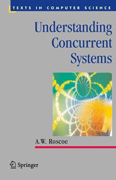
Since the introduction of Hoares’ Communicating Sequential Processes notation, powerful new tools have transformed CSP into a practical way of describing industrial-sized problems. This book presents the fundamental knowledge of CSP concepts readers require to take advantage of those tools. This text benefits from the author’s ten years of teaching experience to guide the reader throughan introductory course on the theory and practice of concurrency. The book isdivided into three parts; the first begins with an introductory course into the theories behind computer concurrency. The second part summarises the main ideas and results featuring chapters on advanced specification techniques, buffer tolerance, induction and data independence. The final part focuses on practice, containing chapters on the bully algorithms and deadlock. Bridging the gap between theory and practice, this logical and practical guide provides readers with in-depth examples explained, and shown in practice." Featuring new chapters on specification techniques, buffer tolerance and induction and data independence, this book will provide readers with a comprehensive and updated guide to the field This essential reference text seamlessly links theory with practice, as well as providing additional materials online INDICE: Preface.- Introduction.- A Foundation Course in CSP.- Fundamental Concepts.- Parallel Operators, Hiding and Renaming.- Piping and Enslavement.- Buffers and Communication.- Termination and Sequential Composition.- Theory.- Operational Semantics.- Denotational Semantics.- Analyzing the Denotational Models.- Infinite Traces.- Algebraic Semantics.- Abstraction.- Practice.- Deadlock.- Modelling Discrete Time.- Case Studies.- Mathematical Background.- A Guide to Machine-Readable CSP.- The Operation of FDR.- Notation.- Bibliography.- Index.- Index of Named Processes
- ISBN: 978-1-84882-257-3
- Editorial: Springer
- Encuadernacion: Cartoné
- Páginas: 440
- Fecha Publicación: 01/07/2010
- Nº Volúmenes: 1
- Idioma: Inglés
